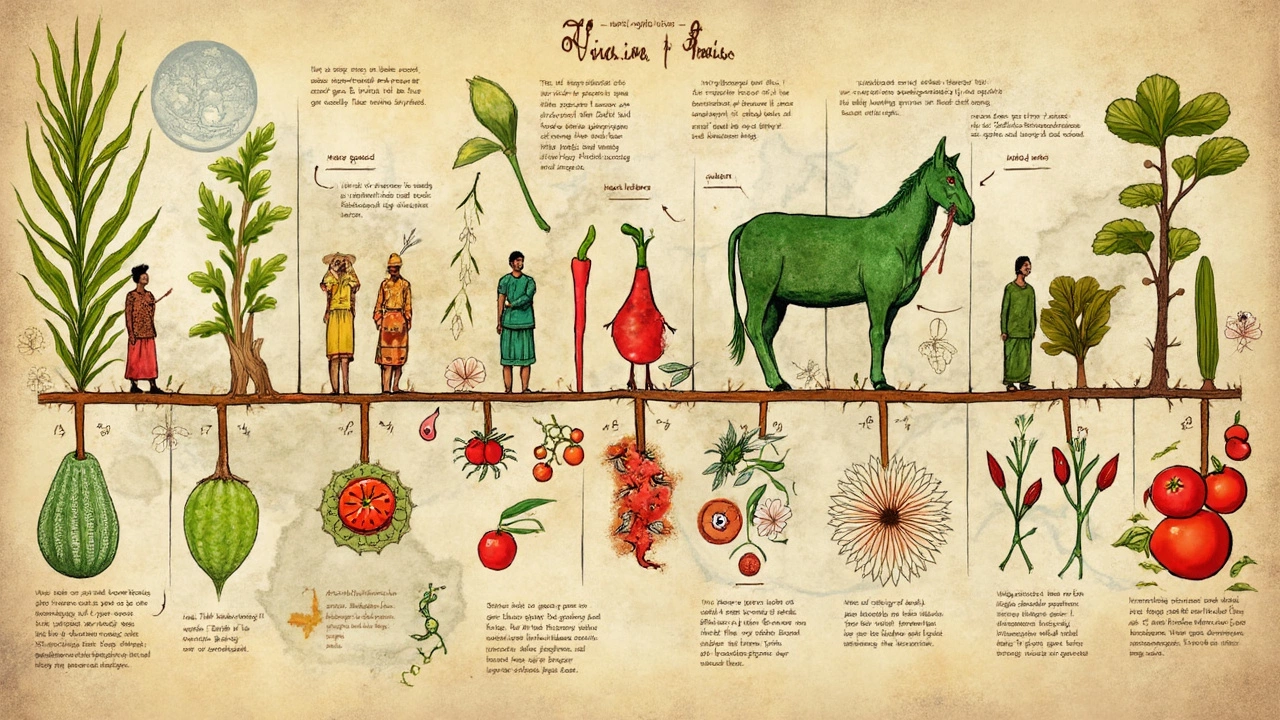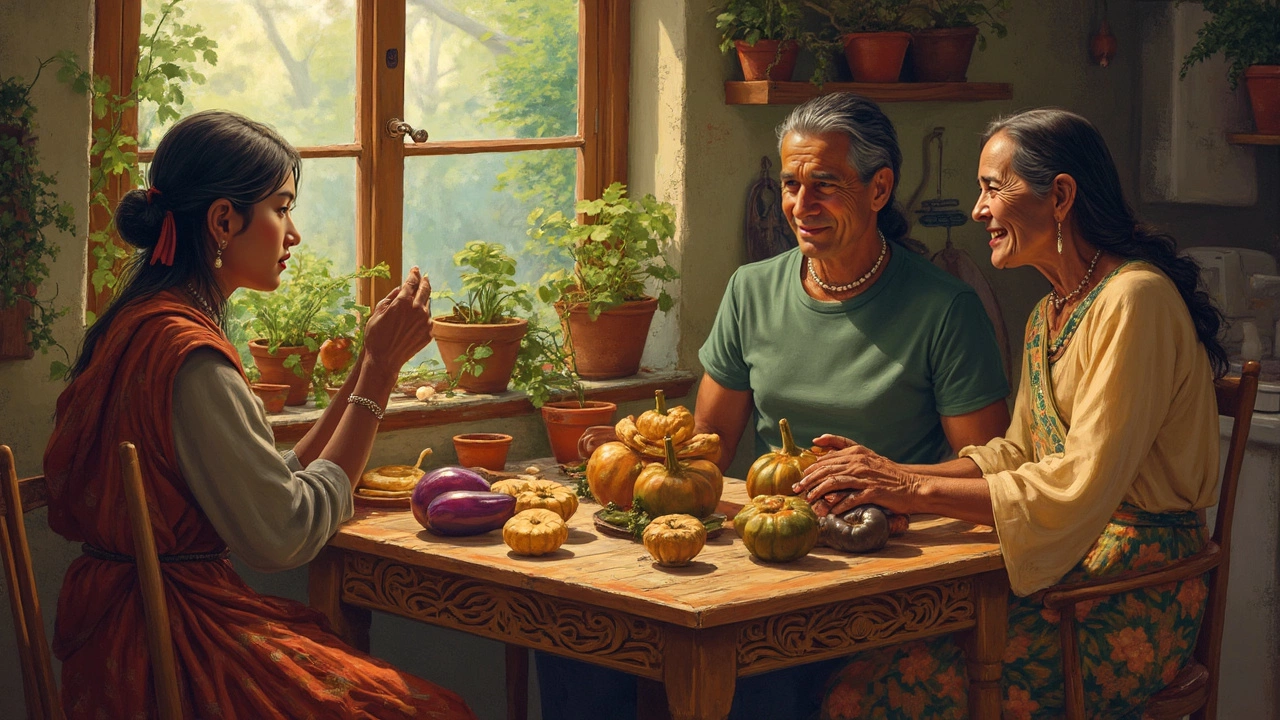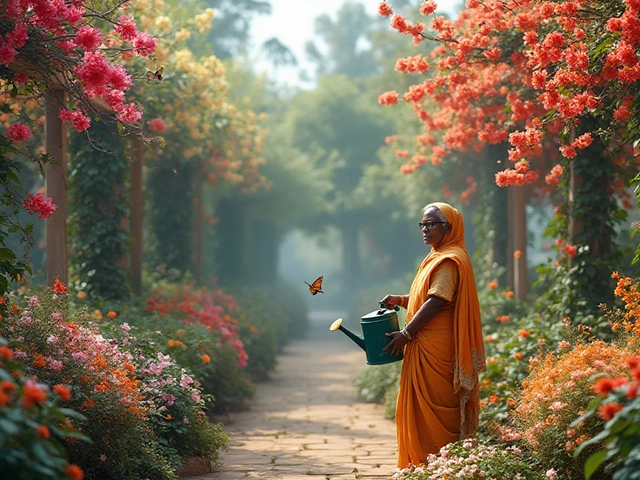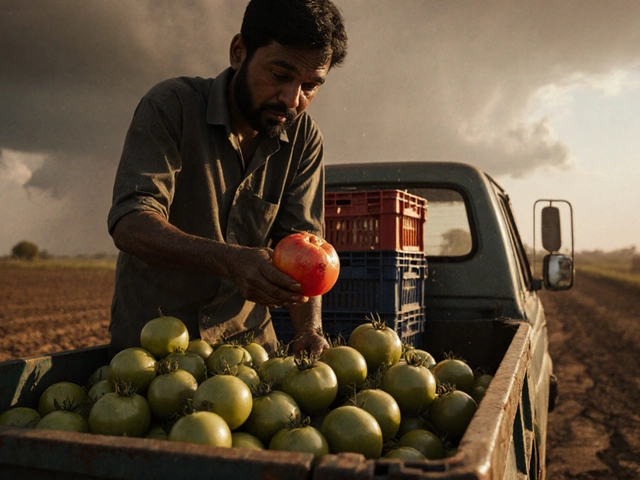Think tomatoes and potatoes are Indian? Not even close—they were brought from the Americas a few hundred years ago. If you want to grow a genuine Indian kitchen garden, you need to start with veggies that have actually been growing here since ancient times.
But finding out what’s truly native isn’t as simple as walking through a local market. A lot of what we see in stores—chillies, carrots (the orange ones), and even cabbage—were introduced at different points in history. The real local legends are things like bitter gourd (karela), Indian eggplant (brinjal), drumstick (moringa), and amaranth greens. These plants aren’t just old-timers; they often grow better in Indian soil and climate, and come packed with nutrition that matches what our bodies actually need here.
Before you buy seeds or saplings for your garden, it pays to know where your veggies truly come from. Native veggies don’t just do better—they carry centuries of tradition and taste you won’t get from imports. Ready to spot the originals and start growing smarter?
- What Makes a Vegetable 'Native'?
- Original Indian Vegetables: A Surprising List
- Interesting Stories Behind Popular Crops
- Tips for Growing Native Vegetables
- Why Native Options Matter for Your Garden
What Makes a Vegetable 'Native'?
So what does it actually mean when people call a vegetable 'native'? It comes down to how long a plant has been growing in a region, how it fits into local farming traditions, and whether it’s been shaped by the climate and soil over thousands of years. If a vegetable popped up naturally in the wild here and locals farmed it long before things like global trade existed, you’re looking at a real native.
Take vegetable gardening India as an example. Just because we use something every day doesn’t mean it belongs here originally. Tomatoes, potatoes, and even chillies feel pretty Indian now, but all three are actually from the Americas. They only landed on Indian soil after the Portuguese started trading in the 16th and 17th centuries. Before that, home cooks never saw these vibrant veggies.
The true Indian natives—think bitter gourd, Indian cucumbers, ridge gourd, and leafy greens like amaranth—have been here for thousands of years. Scientists track this using old texts, archaeological digs, and even looking at genetic differences. A native crop will have wild relatives in the local forests and old records in Ayurvedic or ancient farming documents.
If you want to spot a native, ask these questions:
- Did this vegetable grow wild in India, or did it come from somewhere else?
- Was it part of diets, medicine, or rituals in ancient Indian cultures?
- Does it have wild cousins still thriving in Indian forests or fields?
Understanding what’s native isn’t just trivia—it helps gardeners pick crops that thrive with less fuss, need less water, and stand strong against local pests. Growing native means you get healthier (and usually tastier) veggies without constant chemical fixes or too much pampering.
Original Indian Vegetables: A Surprising List
When you think about vegetable gardening in India, you’d be surprised how many of our daily staples are imports. The cool thing is, India’s native vegetables aren’t just regular greens—they’re packed with nutrition, adapted to hot climates, and form the backbone of traditional recipes.
Here’s a rundown of real-deal native Indian vegetables you can bet on:
- Amaranth (Chaulai): Grows wild and in gardens. This leafy green thrives in all kinds of soil, and you’ll see it in everything from dals to stir-fries. Super rich in iron and calcium.
- Bitter Gourd (Karela): This is as Indian as it gets. You’ll find karela in every old-school veggie patch. Locals swear by its health benefits—especially controlling blood sugar.
- Drumstick (Moringa): If you want one plant to cover nutrition, Moringa is unbeatable. Every part is useful—from the leaves in sabzi to the pods in sambar.
- Ridge Gourd (Turai/Tori): Easy to grow, productive, and does well in heat. Most backyards can handle a vine or two crawling on a fence.
- Brinjal (Indian Eggplant, Baingan): Unlike the big purple eggplants found elsewhere, India’s small, round varieties are native and super versatile.
- Pointed Gourd (Parwal): Grows best in hot, humid weather—a staple in eastern India, especially in summer.
- Snake Gourd (Chichinda): This climbing veggie fits right in with the Indian monsoon. Long fruits, crisp texture, and a favorite in curries.
- Indian Bean (Valor/Hyacinth Bean): Rarely seen outside India, these beans come up every winter in rural kitchen gardens.
To put it in context, here’s a quick comparison of some veggies actually native to India versus common imports:
| Vegetable | Native to India? | Main Growing Season |
|---|---|---|
| Amaranth (Chaulai) | Yes | Year-round |
| Bitter Gourd (Karela) | Yes | Summer, Rainy |
| Drumstick (Moringa) | Yes | Spring, Summer |
| Tomato | No | Winter |
| Potato | No | Winter |
| Brinjal (small, round types) | Yes | Year-round |
So, if you’re planning your own kitchen garden, give these true-blue Indian veggies a shot. They’re not only healthier but also more likely to perform well with fewer pests and less fuss. Focusing on vegetable gardening India just got a whole lot easier—and more authentic!

Interesting Stories Behind Popular Crops
It’s wild how many veggies we eat every day actually have dramatic, unexpected backstories. Take brinjal, for example. In the heart of every vegetable gardening India setup, you’ll find brinjal (baingan). This purple eggplant didn’t come from Europe, but sprouted up along the Indian subcontinent thousands of years ago. Ancient Sanskrit texts called it 'Vatinagana,' and it’s been a staple in Indian kitchens, from bharta up north to sambar down south.
Now, let’s look at bitter gourd (karela). Farmers have grown karela in India since well before the Mughal empire. It’s famous for its sharp taste and power to help manage blood sugar. Karela might be tough for some palates, but its health benefits are hard to deny. Actually, in 2023, the National Institute of Nutrition reported that 92% of karela grown in South Asia comes from India itself.
Moringa (drumstick) almost looks too good to be true. Native to India’s hotter, drier zones, every part of this tree is edible—leaves, pods, even the flowers. Moringa leaves pack more vitamin C than oranges and more calcium than milk. You’ll find it in everything from curry to chutney, making it truly a superfood long before the rest of the world noticed.
Ever heard of amaranth (chaulai)? This local green played a big role during times of scarcity. It grows fast, handles tough weather, and can be cooked just like spinach. Amaranth seeds are high in protein and useful for gluten-free diets, while the leaves are loaded with iron and vitamins. In the past decade, demand for amaranth greens has increased by over 30% among Indian urban gardeners.
Here’s a quick table to show when some popular crops actually came to India and which have real roots here:
| Crop | Native to India? | First Widely Grown |
|---|---|---|
| Brinjal (Eggplant) | Yes | Ancient times |
| Tomato | No | 1600s (from South America) |
| Bitter Gourd | Yes | Ancient times |
| Moringa (Drumstick) | Yes | Ancient times |
| Chilli | No | 1500s (from Americas) |
Knowing these stories isn’t just about trivia—it can help you pick what’s more likely to thrive in your garden and what’s actually suited to our climate. Plus, it gives you bragging rights the next time someone calls tomatoes an Indian classic veggie!
Tips for Growing Native Vegetables
When it comes to vegetable gardening India, native veggies are hands-down the easiest and most reliable. These plants are basically built for Indian seasons—hot summers, crazy monsoons, and even patchy soil. Here’s how you can get the best results from your indigenously grown favorites:
- Know Your Plant’s Season: For example, amaranth (chaulai) loves the heat and can be sown in early summer, while drumstick (moringa) trees want a spot with at least six hours of sunlight even in peak monsoon.
- Start with Healthy Seeds: Get seeds from a trusted local supplier, not random packets at the supermarket. Native seeds often have better resistance to local pests and adjust well.
- Watch Your Watering: Bitter gourd and brinjal both need consistent moisture but hate soggy roots. Use well-draining soil and water early in the morning before it gets hot.
- Feed Them Naturally: Native Indian vegetables thrive with desi compost or aged manure. Use kitchen waste (vegetable peels, tea leaves) for a nutrient kick, and skip artificial fertilizers if you can help it—they aren’t needed half the time!
- Pest Patrol, The Local Way: Neem oil is a lifesaver against common pests like aphids and whiteflies. Turmeric dissolved in water can help control root fungi. Don’t rush for chemical sprays—simple homemade fixes work great, especially on these tough plants.
- Harvest Often: Amaranth and other leafy greens taste better when you pick the young leaves regularly. This also encourages fresh growth and keeps the plant bushy.
Here’s a quick table with the top native vegetables, their preferred season, and water needs. Bookmark it for a quick reminder:
| Vegetable | Planting Season | Watering Needs |
|---|---|---|
| Amaranth (Chaulai) | March to July | Moderate, keep soil moist |
| Bitter Gourd (Karela) | June to July | Regular, avoid waterlogging |
| Brinjal (Baingan) | August to October | Consistent, well-drained |
| Drumstick (Moringa) | February to March | Low once established, water well early on |
So, if you want a garden that’s low on hassle and high on yield, stick with these time-tested native veggies and give them what they love. You’ll get better results with fewer headaches—straight from the soil, the way it was meant to be.

Why Native Options Matter for Your Garden
Growing native vegetables in your Indian kitchen garden isn’t just about sticking to tradition—it makes gardening simpler and more rewarding. These plants are built for the local weather, pests, and soil. So, you spend less money on chemical sprays, fertilizers, and fancy soil fixes. Most native veggies can handle heat spells and sudden rains way better than imported varieties.
Take bitter gourd (karela) or Indian eggplant (brinjal) as examples. These have been part of Indian diets since before chillies and tomatoes even arrived. They’re packed with nutrients and are less likely to be wiped out by local pests because they've spent centuries adapting to the environment.
Native vegetables also attract fewer pests overall because local pests tend to ignore them for something new (like tomatoes). Less pest pressure means less work and fewer chemicals in your food. Plus, these crops support helpful insects and birds, keeping your garden’s natural balance intact.
Another big win: growing native plants is good for water use. Traditional veggies like amaranth (chaulai) need less watering compared to imported veggies like broccoli. That means you’ll save water on top of getting a better harvest.
Here’s why choosing native vegetables for your vegetable gardening India project is a smart move:
- Lower maintenance and costs—needs less fertilizer and fewer pesticides.
- Better survival during tough Indian summers and unpredictable monsoons.
- Bigger harvests with less effort.
- Healthier crops loaded with nutrients that fit local diets.
- Boosts local biodiversity by helping native birds, bees, and butterflies thrive.
If you want a garden that basically runs itself, gives top-class nutrition, and fits your local landscape, going native is the way to do it.





